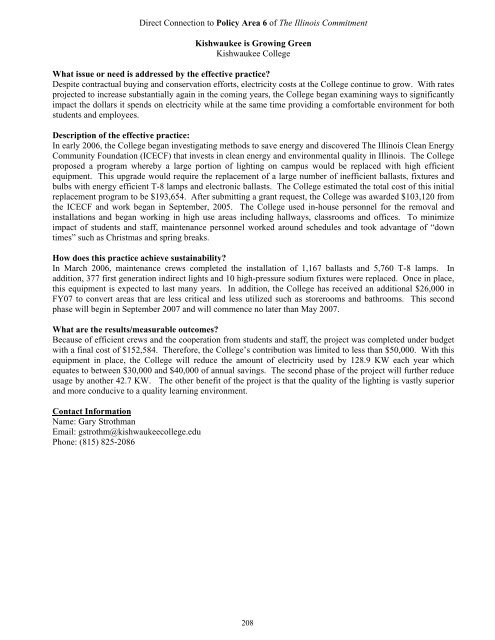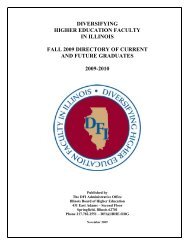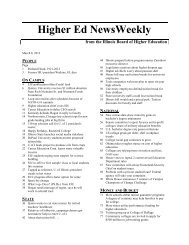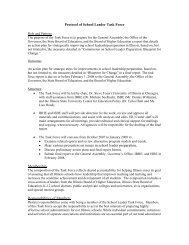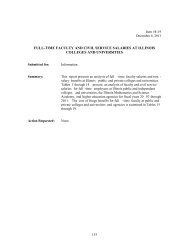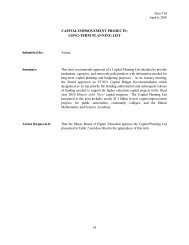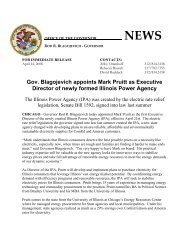Title of Effective Practice: - California Postsecondary Education ...
Title of Effective Practice: - California Postsecondary Education ...
Title of Effective Practice: - California Postsecondary Education ...
Create successful ePaper yourself
Turn your PDF publications into a flip-book with our unique Google optimized e-Paper software.
Direct Connection to Policy Area 6 <strong>of</strong> The Illinois Commitment<br />
Kishwaukee is Growing Green<br />
Kishwaukee College<br />
What issue or need is addressed by the effective practice?<br />
Despite contractual buying and conservation efforts, electricity costs at the College continue to grow. With rates<br />
projected to increase substantially again in the coming years, the College began examining ways to significantly<br />
impact the dollars it spends on electricity while at the same time providing a comfortable environment for both<br />
students and employees.<br />
Description <strong>of</strong> the effective practice:<br />
In early 2006, the College began investigating methods to save energy and discovered The Illinois Clean Energy<br />
Community Foundation (ICECF) that invests in clean energy and environmental quality in Illinois. The College<br />
proposed a program whereby a large portion <strong>of</strong> lighting on campus would be replaced with high efficient<br />
equipment. This upgrade would require the replacement <strong>of</strong> a large number <strong>of</strong> inefficient ballasts, fixtures and<br />
bulbs with energy efficient T-8 lamps and electronic ballasts. The College estimated the total cost <strong>of</strong> this initial<br />
replacement program to be $193,654. After submitting a grant request, the College was awarded $103,120 from<br />
the ICECF and work began in September, 2005. The College used in-house personnel for the removal and<br />
installations and began working in high use areas including hallways, classrooms and <strong>of</strong>fices. To minimize<br />
impact <strong>of</strong> students and staff, maintenance personnel worked around schedules and took advantage <strong>of</strong> “down<br />
times” such as Christmas and spring breaks.<br />
How does this practice achieve sustainability?<br />
In March 2006, maintenance crews completed the installation <strong>of</strong> 1,167 ballasts and 5,760 T-8 lamps. In<br />
addition, 377 first generation indirect lights and 10 high-pressure sodium fixtures were replaced. Once in place,<br />
this equipment is expected to last many years. In addition, the College has received an additional $26,000 in<br />
FY07 to convert areas that are less critical and less utilized such as storerooms and bathrooms. This second<br />
phase will begin in September 2007 and will commence no later than May 2007.<br />
What are the results/measurable outcomes?<br />
Because <strong>of</strong> efficient crews and the cooperation from students and staff, the project was completed under budget<br />
with a final cost <strong>of</strong> $152,584. Therefore, the College’s contribution was limited to less than $50,000. With this<br />
equipment in place, the College will reduce the amount <strong>of</strong> electricity used by 128.9 KW each year which<br />
equates to between $30,000 and $40,000 <strong>of</strong> annual savings. The second phase <strong>of</strong> the project will further reduce<br />
usage by another 42.7 KW. The other benefit <strong>of</strong> the project is that the quality <strong>of</strong> the lighting is vastly superior<br />
and more conducive to a quality learning environment.<br />
Contact Information<br />
Name: Gary Strothman<br />
Email: gstrothm@kishwaukeecollege.edu<br />
Phone: (815) 825-2086<br />
208


